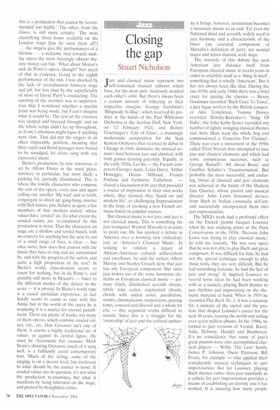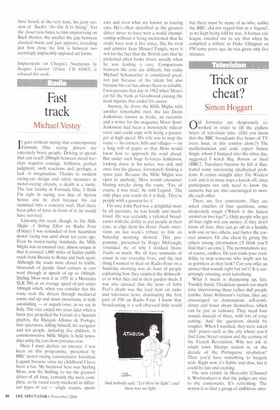Closing the gap
Stuart Nicholson
Jazz and classical music represent two self-contained musical cultures which have, for the most part, studiously avoided each other's orbit. But there's always been a certain amount of tinkering at their respective margins. George Gershwin's 'Rhapsody In Blue', which received its premier at the hands of the Paul Whiteman Orchestra at the Aeolian Hall, New York, on 12 February 1924, and Robert Graettinger's 'City of Glass', a stunningly modernistic composition for the Stan Kenton Orchestra that received its debut in Chicago in 1948, dominate the musical noman's land between jazz and classical, with both genres denying paternity. Equally, in the early 1920s, Les Six — the French composers Georges Auric, Louis Durcy, Arthur Honegger, Darius Milhaud, Francis Poulenc and Germaine Tailleferre — shared a fascination with jazz that provided a source of inspiration in their own works where, they claimed, they 'fused art and modern life', so challenging Impressionism in the hope of invoking a new French artmusic based on popular sources.
But classical music is not jazz, and jazz is not classical music. This is something the jazz trumpeter Wynton Marsalis is at pains to point out. He has sparked a debate in America over a looming new orthodoxy: jazz as 'America's Classical Music'. In seeking to validate a legacy of African–American cultural achievement and excellence, he and the writers Albert Murray and Stanley Crouch deny that jazz has any European component. But since jazz makes use of the same harmonic elements as European classical music — primary triads, diminished seventh chords, whole tone scales, augmented chords, chords with added notes, parallelism, modes, chromaticism, suspensions, passing tones, concord and discord and a whole lot else — this argument seems difficult to sustain, Since this is a struggle for the 'ownership' of jazz and the cultural author
ity it brings, however, revisionism becomes a necessary means to an end. Yet even the flattened third and seventh, widely used in jazz harmony and a characteristic of the blues (an essential component of Marsalis's definition of jazz), are normal major and minor diatonic scale steps.
The intensity of this debate has seen American jazz distance itself from European classical music in recent years in order to establish itself as a 'thing in itself, something that is wholly 'American'. But it has not always been like that. During the late 1930s and early 1940s there was a brief craze for jazzing the classics — Benny Goodman recorded 'Bach Goes To Town', a jazz fugue written by the British composer Alec Templeton, Tommy Dorsey recorded Rimsky-Korsakov's 'Song Of India', the John Kirby Sextet recorded any number of tightly swinging classical themes and Artie Shaw went the whole hog and commissioned a 'Concerto For Clarinet'. There was even a movement in the 1950s called Third Stream that attempted to fuse jazz and classical elements and which had some conspicuous successes, such as George Russell's 'All About Rosie' and Gunther Schuller's 'Transformation'. But probably the most successful, and enduring, blend of classical and jazz elements was achieved at the hands of the Modern Jazz Quartet, whose pianist and musical director John Lewis borrowed devices from Bach to Italian cornmedia dell'arte and successfully incorporated them into jazz expressionism.
The MJQ's work had a profound effect on the French pianist Jacques Loussier when he was studying piano at the Paris Conservatory in the 1950s. 'Because John Lewis was trying to play classical music,' he told me recently. 'He was very upset that he was not able to play Bach and great composers. It was difficult for him, he had not the special technique enough to play those texts, they are very difficult. But he had something fantastic, he had the feel of jazz and swing!' It inspired Loussier to record some ideas he had been working with as a student, playing Bach themes to jazz rhythms and improvising on the thematic material at hand. When in 1959 he recorded Play Bach No. I, it was a runaway hit, a mixture of the sacred and the profane that shaped Loussier's career for the next 40 years, touring the world and selling over seven million albums. In the 1990s, he turned to jazz versions of Vivaldi, Ravel, Satie, Debussy, Handel and Beethoven. It's no coincidence that some of jazz's great pianists were also accomplished classical players — Willie 'The Lion' Smith, James P. Johnson, Oscar Peterson, Bill Evans, for example — who applied their considerable musical techniques to jazz improvisation. But for Loussier, playing Bach themes rather than jazz standards as a vehicle for jazz improvisation provides a means of establishing an identity and it has worked. It is amazing how many people
have heard, at the very least, his jazzy version of Bach's 'Air On A G String'. Yet the closer you listen to him improvising on Bach themes, the smaller the gap between classical music and jazz appears, revealing just how close the link is between two seemingly implacably opposed art forms.
Impressions on Chopin's Nocturnes by Jacques Loussier (Marc CD 83602) is released this week.



























































































































 Previous page
Previous page